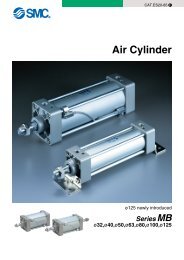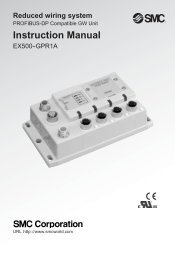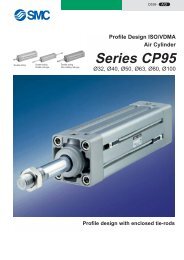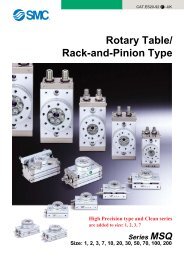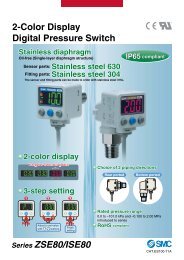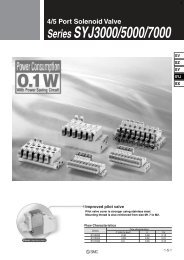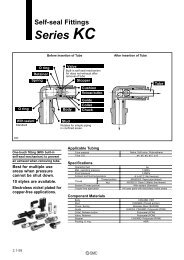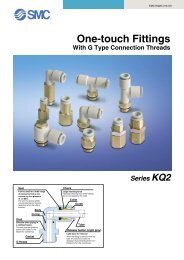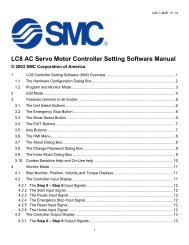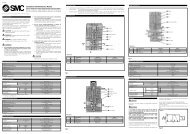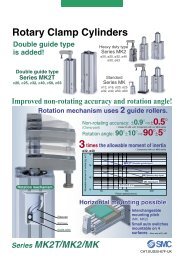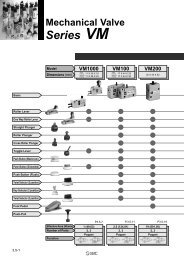You also want an ePaper? Increase the reach of your titles
YUMPU automatically turns print PDFs into web optimized ePapers that Google loves.
<strong>Series</strong> AF10 to AF60Working Principle: Float Type Auto DrainN.O. type: AD38, AD48N.C. type: AD37, AD47Compact auto drainN.C. type: AD17, AD27qrewtiyuo!0BowlValveLeverFloatValve seatChamberSpringPistonHousingSealBowlValveLeverFloatValve seatChamberPistonSpringHousing!1 Drain cockDrain cockDrainqrewtiuyo!0!1SealqwertyBowlFloatLeverValveValve seatKnobDrainDrain• When pressure inside the bowl is released:When pressure is released from the bowl q,piston u is lowered by spring y.The sealing action of seal !0 is interrupted, andthe outside air flows inside the bowl q, throughhousing hole o and drain cock !1.Therefore, if there is an accumulation of condensatein the bowl q, it will drain out throughthe drain cock.• When pressure is applied inside thebowl:When pressure exceeds 0.1 MPa, the force ofpiston u surpasses the force of spring y, andthe piston goes up.This pushes seal !0 up so that the it creates aseal and the inside of the bowl q, is shut offfrom the outside air.If there is no accumulation of condensate in thebowl q, at this time float w will be pulled downby its own weight, causing valve r, which isconnected to lever e, to seal valve seat t.• When there is an accumulation ofcondensate in the bowl:Float w rises due to its own buoyancy and pushesopen the seal created by the valve seat, t.This allows the pressure inside the bowl q, toenter the chamber i. The result is that thecombined pressure inside chamber i and theforce of the spring y, lowers the piston u.This causes the sealing action of seal !0 to beinterrupted, and the accumulated condensate inthe bowl q, drains out through the drain cock!1.Turning drain cock !1 manually counterclockwiselowers piston u, which pushes open theseal created by seal !0, thus allowing the condensateto drain out.31• When pressure inside the bowl is released:Even when pressure inside the bowl q, is released,spring y keeps piston u in its upwardposition.This keeps the seal created by the seal !0, inplace, thus shutting the outside air from insidethe bowl q.Therefore, even if there should be some condensateaccumulation inside the bowl q, it willnot drain out.• When pressure is applied inside thebowl:Even when pressure is applied inside the bowlq, the combined force of spring y and thepressure inside the bowl q, keeps piston u inits upward position.This maintains the seal created by the seal !0,in place, thus shutting the outside air from insidethe bowl q.If there is no accumulation of condensate in thebowl q, at this time float w will be pulled downby its own weight, causing valve r, which isconnected to lever e, to seal valve seat t.• When there is an accumulation ofcondensate in the bowl:Float w rises due to its own buoyancy and pushesopen the seal created by the valve seat t.Pressure passes from the bowl q to chamber i.The result is that the pressure inside chamberi surpasses the force of the spring y, andpushes piston u downwards.This causes the sealing action of seal !0 to beinterrupted and the accumulated condensate inthe bowl q, drains out through the drain cock !1.Turning drain cock !1 manually counterclockwiselowers piston u, which pushes open theseal created by seal !0, thus allowing the condensateto drain out.• When pressure inside the bowl isreleased:Even when pressure inside the bowl q, isreleased, the weight of the float w causesvalve r, which is connected to lever e, to sealvalve seat t. As a result, the inside of the bowlq, is shut off from the outside air.Therefore, even if there is an accumulation ofcondensate in the bowl q, it will not drain out.• When pressure is applied inside thebowl:Even when pressure is applied inside the bowlq, the weight of the float w, and thedifferential pressure that is applied to valve rcauses valve r to seal valve seat t, and theoutside air is shut off from the inside of thebowl q.• When there is an accumulation ofcondensate in the bowlFloat w rises due to its own buoyancy and theseal at valve seat t is interrupted.The condensate inside the bowl q drains outthrough the knob, y.Turning knob y manually counterclockwiselowers it and causes the sealing action of valveseat t to be interrupted, thus allowing thecondensate to drain out.



